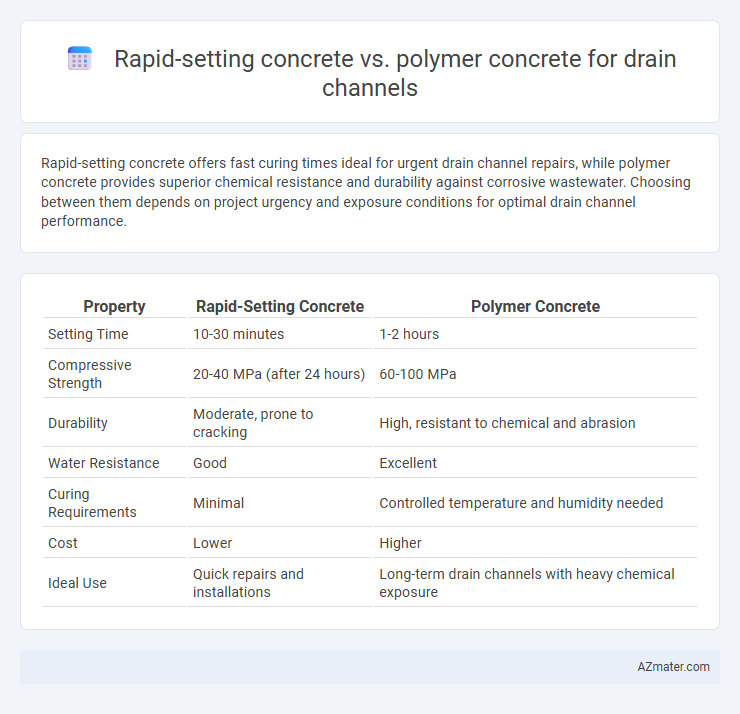Rapid-setting concrete offers fast curing times ideal for urgent drain channel repairs, while polymer concrete provides superior chemical resistance and durability against corrosive wastewater. Choosing between them depends on project urgency and exposure conditions for optimal drain channel performance.
Table of Comparison
| Property | Rapid-Setting Concrete | Polymer Concrete |
|---|---|---|
| Setting Time | 10-30 minutes | 1-2 hours |
| Compressive Strength | 20-40 MPa (after 24 hours) | 60-100 MPa |
| Durability | Moderate, prone to cracking | High, resistant to chemical and abrasion |
| Water Resistance | Good | Excellent |
| Curing Requirements | Minimal | Controlled temperature and humidity needed |
| Cost | Lower | Higher |
| Ideal Use | Quick repairs and installations | Long-term drain channels with heavy chemical exposure |
Introduction to Drain Channel Materials
Rapid-setting concrete offers fast curing times ideal for minimizing downtime in drain channel installations, with high compressive strength and durability against environmental stressors. Polymer concrete incorporates resin binders, providing superior chemical resistance and enhanced adhesion, making it suitable for harsh or corrosive drainage environments. Both materials improve longevity and structural integrity, but selection depends on factors like site conditions, load requirements, and exposure to chemicals.
Overview of Rapid-Setting Concrete
Rapid-setting concrete for drain channels offers accelerated curing times, enabling faster project completion and minimizing downtime in infrastructure repair. This type features hydraulic cementitious materials that achieve initial set within 15 to 30 minutes and reach functional strength in as little as 1 to 3 hours, making it ideal for emergency repairs and high-traffic areas. Its high early strength and resistance to abrasion and chemical attack ensure durable performance in harsh drainage environments.
Understanding Polymer Concrete
Polymer concrete for drain channels offers superior chemical resistance and higher tensile strength compared to rapid-setting concrete, making it ideal for harsh environmental conditions and aggressive wastewaters. Its composition involves polymer binders, such as epoxy or polyester, which significantly enhance durability, reduce permeability, and enable faster curing times without compromising structural integrity. Understanding polymer concrete's molecular structure reveals how its chemical bonds improve adhesion and resistance to cracking, ensuring long-term performance in channel applications where rapid-setting concrete may suffer from shrinkage and lower resistance to chemical attack.
Key Material Properties Compared
Rapid-setting concrete offers fast curing times and high early strength, making it ideal for urgent drain channel installations requiring quick load-bearing capacity. Polymer concrete, incorporating resins like epoxy or polyester, provides superior chemical resistance, low permeability, and enhanced durability against aggressive wastewater environments. Both materials exhibit excellent compressive strength, but polymer concrete outperforms in flexural strength and resistance to shrinkage, reducing the risk of cracking under dynamic loads.
Installation Process and Time Efficiency
Rapid-setting concrete offers a significantly faster installation process for drain channels, curing within 30 to 60 minutes, which minimizes site downtime and accelerates project completion. Polymer concrete requires a more controlled mixing and curing phase but provides enhanced chemical resistance and durability, making it ideal for environments exposed to harsh chemicals or heavy traffic. The quick turnaround of rapid-setting concrete suits temporary or urgent repairs, while polymer concrete benefits long-term infrastructure with its superior strength and resilience.
Durability and Longevity in Drain Environments
Rapid-setting concrete offers quick strength gain and early load-bearing capacity, but it may exhibit lower chemical resistance and durability in aggressive drain environments compared to polymer concrete. Polymer concrete provides superior resistance to chemical corrosion, abrasion, and moisture ingress, significantly enhancing the longevity of drain channels exposed to wastewater and harsh chemicals. Due to its enhanced durability, polymer concrete is generally preferred for drain channels requiring long-term performance and minimal maintenance under corrosive conditions.
Chemical and Weather Resistance
Rapid-setting concrete exhibits moderate chemical resistance but can degrade under prolonged exposure to harsh chemicals and freeze-thaw cycles, making it less ideal for highly corrosive or extreme weather environments. Polymer concrete offers superior chemical resistance against acids, alkalis, and solvents, along with enhanced durability against weathering, freeze-thaw, and UV radiation, ensuring longer lifespan in demanding drain channel applications. Its low permeability and strong bonding capabilities prevent deterioration, significantly reducing maintenance and repair costs.
Environmental Impact and Sustainability
Rapid-setting concrete for drain channels offers fast curing times and reduced construction delays but typically relies on cement production processes with significant carbon emissions. Polymer concrete, composed of resins and aggregates, provides excellent chemical resistance and durability, often leading to longer service life and reduced maintenance needs, which can lower environmental impact over time. The sustainability of polymer concrete improves when bio-based resins are used, whereas rapid-setting concrete's environmental footprint may be mitigated by incorporating industrial byproducts like fly ash or slag.
Cost Considerations for Drain Channels
Rapid-setting concrete typically offers lower initial material costs, making it a budget-friendly option for drain channels requiring quick installation and early load-bearing capacity. Polymer concrete, while more expensive upfront due to specialized resins and additives, provides superior chemical resistance and durability, potentially reducing long-term maintenance and replacement expenses. Evaluating the total lifecycle cost, including installation speed, durability, and maintenance frequency, is crucial in selecting the most cost-effective material for drain channel projects.
Choosing the Right Concrete for Drain Channel Applications
Rapid-setting concrete offers fast curing times ideal for urgent drain channel repairs, providing high early strength and minimizing downtime. Polymer concrete enhances chemical resistance and durability, making it suitable for drain channels exposed to aggressive fluids or heavy traffic conditions. Selecting the right concrete depends on project-specific factors such as repair urgency, environmental exposure, and load requirements to ensure long-lasting performance.

Infographic: Rapid-setting concrete vs Polymer concrete for Drain channel
 azmater.com
azmater.com